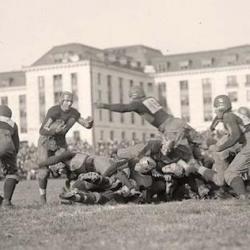Michael Lewis, The Blind Side: Evolution of a Game . New York: W. W. Norton, 2006. Hardback, 299 pp. $24.95.
Over the past two decades, professional football has evolved so that the outcome of games often turns on the performance of one of the least-noticed and least-glamorous men on the field, the left offensive tackle.
During the 1980s, Bill Walsh of the San Francisco 49ers transformed the NFL passing game from a high-risk venture into a precision machine. Quarterback Joe Montana’s stock went through the roof, and as other coaches borrowed from Walsh, quarterbacks throughout the league became more important, and more expensive, than ever before.
About the same time, Bill Parcells of the New York Giants, who believed in brawny violent defense as passionately as Walsh believed in intricately synchronized offense, had acquired the answer to the passing offense: Lawrence Taylor. Taylor turned the quarterback sack into a game-winning play, and put more than one quarterback out of commission with his vicious blind-side charges.
NFL teams had to find a way to neutralize Taylor’s many imitators, and as a result a good left tackle (who blocks on the blind side of right-handed quarterbacks) became one of the most valuable, and most highly paid, players in the league.
Not everyone can do what a left tackle needs to do, because few are what left tackles need to be. Size is crucial, but not sufficient. The ideal left tackle will exceed 300 pounds, but move with the quickness of a much smaller man. He has to be smart enough to learn how to play on the offensive line, a position more complicated than any in football except the quarterback’s.
As a junior in high school, “Big Mike” Oher (pronounced “Oar”) was already an ideal left tackle. Weighing in at 340+, he had spent his youth dreaming of being a shooting guard in basketball, the next Michael Jordan, and his dreams of speed and agility had materialized in a body uncannily combining buoyancy and bulk. Everyone who saw him recognized him as a “freak of nature.”
Oher might have faded into the Memphis projects where he grew up had he not been brought to Briarcrest Christian School in a very white, very wealthy Memphis suburb. With no home to speak of, he began sleeping over in the home of Sean and Leigh Anne Tuohy, and gradually became part of the family. He spent hours playing video games with 10-year-old Sean Jr.
The Tuohys became his legal guardians, bought him clothes, got him a driver’s license, paid for tutors and tuition at Briarcrest, ensured that he graduated from high school, and controlled visits from the salivating college coaches who lined up to beg and buy Oher.
Today, Oher is midway through a football career at the Tuohys alma mater, Ole Miss, and by all accounts expected to be a great NFL lineman.
Displaying a novelist’s gifts for characterization and pacing, journalist Michael Lewis, author of Liar’s Poker and Moneyball , has written a great sports book. Like all great sports books, The Blind Side is much more.
At the center is a moving portrait of a lonely but ambitious and charming boy in a giant’s body, who scored in the 5th percentile in academic testing but in the 90th percentile in “Protective Instincts,” and of his generous and strong-willed parents who, beyond everything else, loved Michael Oher as he had never been loved.















